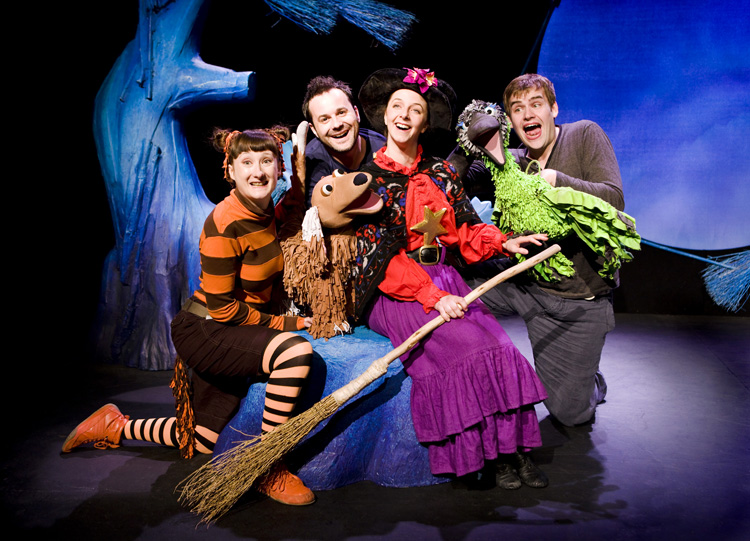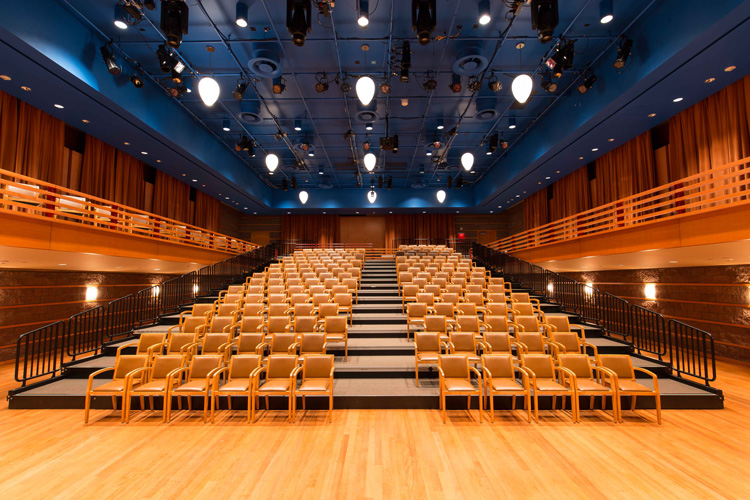By Sharon Stello
On stage, actors are presenting “Room on the Broom”—a children’s tale about the adventures of a witch, her cat and other friends—but in the audience, food wrappers crinkle, voices can occasionally be heard in conversation, a few kids start wandering down the aisle, one girl shouts to the characters and another tries to climb onto the stage as her mother patiently tries to prevent her from doing so.

While this commotion might be distracting to some theater casts, this is no ordinary presentation. The show, which took place in October, was the first in a new set of “sensory friendly” programming offered by Segerstrom Center for the Arts for children with autism and other developmental disorders who may be sensitive to loud noises and other theatrical elements that can cause sensory overload.
These toned-down performances of Family Series shows take place in the Samueli Theater—a smaller, less overwhelming venue on the Segerstrom campus—and are tailored to address such concerns. For instance, the house lights are dimmed but never fully turned off and any sounds and special effects are adjusted to be less startling. In the rendition of “Room on the Broom,” the dragon’s entrance was done in a way so it wouldn’t stun the audience. Other modifications include seating configured with more space and relaxed theater etiquette.

“Getting up out of your seat is totally fine. Having snacks is totally fine,” explains Kay Burnham, associate vice president of guest services at Segerstrom Center. And the use of tablet devices and smartphones is allowed to help calm the child or if it is needed for communication.
Additionally, the theater and lobby are open for an hour before the show so audience members may come early and get comfortable with their surroundings. Patrons also receive a special program that explains what to expect, including photos of the actors in and out of their costumes and makeup. Staff receive extra training on how to handle any situations that arise and, if guests need a break during the performance, an area is set up in the lobby with soft padding and floor pillows; a television monitor also allows them to continue watching the show if they want. But most of all, this is a supportive environment where they won’t suffer a harsh stare or “shh” from others in the audience.
“[It’s for] anyone who is worried that a theater-going experience might be a judgmental experience for them,” says Burnham, who helped develop the programming after a staff member attended a conference about making performances accessible to everyone.
While some Broadway shows such as “The Lion King,” “Mary Poppins” and “Matilda” have worked with the New York-based Theatre Development Fund to create sensory friendly performances, the idea is somewhat new in Southern California. Chance Theater in Anaheim Hills launched a similar program last spring and now Segerstrom Center has introduced its version, with two more shows coming in March.
“We’ve seen it grow more and more,” says Alex Jones, director of education programs at Segerstrom Center, who helped to develop the sensory friendly offerings and believes it’s important to provide an inclusive option for audiences. “We feel like theater’s for everyone.”
That’s the same sentiment expressed by actors in U.K.-based theater company Tall Stories, which presented “Room on the Broom” and has done shows for deaf and blind children before. Alexandra Harman, who plays the cat, adds that performing in a sensory-friendly show is actually “not that different” from performing for any group of young children because they often shout out or run in the aisles.
Fellow actor Luke McConnell, who played the bird and dragon, says he’s willing to do whatever it takes to make a play accessible. “We softened the edges a bit,” he explains, adding that he particularly appreciated the intimate venue at Segerstrom Center. “It’s not overwhelming for them. … You can connect one-on-one with them a little more.”
For example, when a girl came right up to the stage, he improvised, got down low and had the bird puppet talk right to her rather than making it fly up high as planned. And when another girl in the audience shouted out “Be careful” and “The broom broke in two,” Amy Harris, who played the witch, responded in a playful manner, interacting with the audience and incorporating the outburst into the performance.
Parents who brought their children to the show were grateful for the experience. Simran Garcia and her husband love the theater and wanted to expose their kids to it, but traditional performances can be problematic. She came to “Room on the Broom” with her daughter, who has sensory sensitivities and trouble sitting still.
“They really took every detail into consideration. … They did such a great job. I can’t wait till March [for the other shows],” says Garcia, who is the outreach coordinator and OC chapter coordinator of Irvine-based Talk About Curing Autism (TACA), a nonprofit education and support group that helps families affected by autism. Turning to a Segerstrom Center representative in the lobby, she says, “I want to cry, how well you guys nailed it. … To see [the families] leaving and smiling, it makes me so happy.”
———–
Up Next
Two more sensory friendly shows are planned in March at Segerstrom Center for the Arts.
“Big Bad Wolf”
March 5 at 10 a.m.; Samueli Theater
This alternative take on the “Little Red Riding Hood” fairy tale presents the Big Bad Wolf as a misunderstood character who, in an unlikely turn of events, becomes friends with Heidi Hood, who is Little Red’s second cousin twice removed. The 50-minute play, presented by Windmill Theatre of Australia, entertains with dancing, puppetry and a poetry competition.
“Egg”
March 19 at 10 a.m.; Samueli Theater
Co-winner of the Best Production for Young People at The Off West End Theatre Awards in 2014, this presentation by Cahoots NI of Northern Ireland addresses the theme of flying the nest. Music, illusion and physical theater combine for the story about a group of birds and their many adventures.




